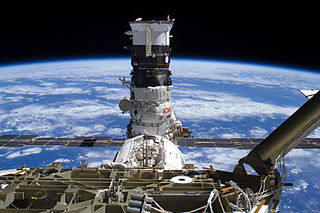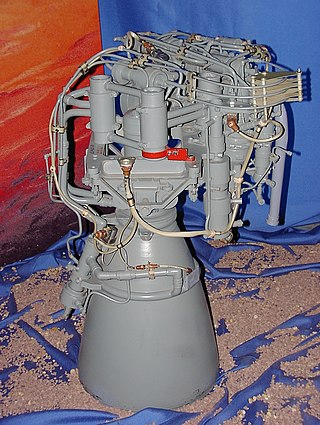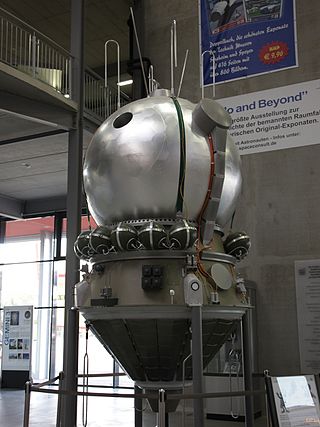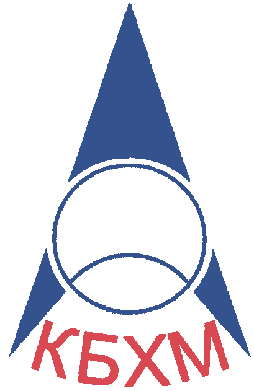Related Research Articles

Soyuz is a series of spacecraft which has been in service since the 1960s, having made more than 140 flights. It was designed for the Soviet space program by the Korolev Design Bureau. The Soyuz succeeded the Voskhod spacecraft and was originally built as part of the Soviet crewed lunar programs. It is launched on a Soyuz rocket from the Baikonur Cosmodrome in Kazakhstan. Between the 2011 retirement of the Space Shuttle and the 2020 demo flight of SpaceX Crew Dragon, the Soyuz served as the only means to ferry crew to or from the International Space Station, for which it remains heavily used. Although China did launch crewed Shenzhou flights during this time, none of them docked with the ISS.

The Progress is a Russian expendable cargo spacecraft. Its purpose is to deliver the supplies needed to sustain a human presence in orbit. While it does not carry a crew, it can be boarded by astronauts when docked to a space station, hence it is classified as crewed by its manufacturer. Progress is derived from the crewed Soyuz spacecraft and launches on the same launch vehicle, a Soyuz rocket.

The Almaz program was a highly secret Soviet military space station program, begun in the early 1960s.

Kliper was an early-2000s proposed partially-reusable crewed spacecraft concept by RSC Energia. Due to lack of funding from the ESA and RSA, the project was indefinitely postponed by 2006.

Zarya, also known as the Functional Cargo Block or FGB, is the first module of the International Space Station to have been launched. The FGB provided electrical power, storage, propulsion, and guidance to the ISS during the initial stage of assembly. With the launch and assembly in orbit of other modules with more specialized functionality, as of August 2021 it is primarily used for storage, both inside the pressurized section and in the externally mounted fuel tanks. The Zarya is a descendant of the TKS spacecraft designed for the Soviet Salyut program. The name Zarya ("Dawn") was given to the FGB because it signified the dawn of a new era of international cooperation in space. Although it was built by a Russian company, it is owned by the United States.

The RD-58 is a rocket engine, developed in the 1960s by OKB-1, now RKK Energia. The project was managed by Mikhail Melnikov, and it was based on the previous S1.5400 which was the first staged combustion engine in the world. The engine was initially created to power the Block D stage of the Soviet Union's abortive N-1 rocket. Derivatives of this stage are now used as upper stages on some Proton and Zenit rockets. An alternative version of the RD-58 chamber, featuring a shorter nozzle, was used as the N-1's roll-control engine.

The Soyuz-TMA is a spacecraft used by the Russian Federal Space Agency for human spaceflight. It is a revision of the Soyuz spacecraft and was superseded in 2010 by the Soyuz TMA-M.(T – транспортный – Transportnyi – meaning transport, M – модифицированный – Modifitsirovannyi – meaning modified, A – антропометрический, – Antropometricheskii meaning anthropometric). The spacecraft features several changes to accommodate requirements requested by NASA in order to service the International Space Station, including more latitude in the height and weight of the crew and improved parachute systems. It is also the first expendable vehicle to feature a "glass cockpit". Soyuz-TMA looks identical to the earlier Soyuz-TM spacecraft on the outside, but interior differences allow it to accommodate taller occupants with new adjustable crew couches.

Poisk, also known as the Mini-Research Module 2, Малый исследовательский модуль 2, or МИМ 2, is a docking module of the International Space Station. Its original name was Docking Module 2, as it is almost identical to the Pirs Docking Compartment. Added in 2009, Poisk was the first major Russian addition to the International Space Station since 2001. Poisk is overall the same design as the docking module Pirs. Whereas Pirs was attached to the nadir ("bottom") port of Zvezda, Poisk is attached to the zenith ("top"); Pirs was closer to the Earth with the ISS in its usual orientation, and Poisk is on the other side. Poisk is Russian for explore or search. Poisk combines various docking, EVA, and science capabilities. It has two egress hatches for EVAs in addition to the two spacecraft docking ports. Although Poisk is designated as Mini-Research Module 2, it arrived before Mini-Research Module 1 (Rassvet), which had a different design; Poisk looks more like the Pirs docking port, which is not designated as a mini-research module.

Orel or Oryol, formerly Federation, and PPPTS, is a project by Roscosmos to develop a new-generation, partially reusable crewed spacecraft.
The Zarya spacecraft was a secret Soviet project of the late 1980s aiming to design and build a large crewed vertical-takeoff, vertical-landing (VTVL) reusable space capsule, a much larger replacement for the Soyuz (spacecraft). The project was developed during 1985–1989 years by Energia corporation until it was shelved in 1989, "on the eve of the Soviet Union's collapse" due to lack of funding. The name of the project was later reused by the Zarya space station module which served as the first component of International Space Station in 1998.

Progress M-19M, identified by NASA as Progress 51P, is a Progress spacecraft used by Roskosmos to resupply the International Space Station during 2013. Progress M-19M was launched on a standard 2-day rendezvous profile towards the ISS. The 19th Progress-M 11F615A60 spacecraft to be launched, it had the serial number 419 and was built by RKK Energia.
KVD-1 was an upper stage LOX/LH2 cryogenic engine developed by the Isayev Design Bureau (now KB KhIMMASH) of Russia in the early 1960s. It is a modified version of the RD-56, developed for a never-completed cryogenic upper stage of the N-1 super-heavy lift rocket, with the goal of enabling crewed lunar missions by the USSR. The KVD-1 produces a thrust of 7.5 tonnes.

The S5.92 is a Russian rocket engine, currently used on the Fregat upper stage.

The S5.4, was a Russian liquid rocket engine burning TG-02 and AK20F in the gas generator cycle. It was originally used as the braking (deorbit) engine of the Vostok, Voskhod, and Zenit spacecraft, which later switched to solid engines.
The KTDU-35 was a Soviet spacecraft propulsion system composed of two liquid rocket engines, the primary, S5.60 (SKD) and the secondary S5.35 (DKD), fed from the same propellant tanks. Both engines burn UDMH and AK27I in the gas generator cycle. It was designed by OKB-2, the famous Isaev Design Bureau, for the original Soyuz programme.

The KTDU-80 (Russian: Корректирующе-Тормозная Двигательная Установка, КТДУ) is the latest of a family of integrated propulsion system that KB KhIMMASH has implemented for the Soyuz since the Soyuz-T. It integrates main propulsion, RCS and attitude control in a single system pressure fed from a common dual string redundant pressurized propellant system. The common propellant is UDMH and N2O4 and the main propulsion unit, is the S5.80 main engine. It generates 2.95 kN (660 lbf) of thrust with a chamber pressure of 880 kPa (128 psi) and a nozzle expansion of 153.8 that enables it to achieve a specific impulse of 302 s (2.96 km/s). It is rated for 30 starts with a total firing time of 890 seconds. The integrated system without the pressurization or tanks weighs 310 kg (680 lb); it is 1.2 m (47 in) long with a diameter of 2.1 m (83 in).

The A.M. Isayev Chemical Engineering Design Bureau, also known as KB KhimMash or just KBKhM, is a Russian rocket engine design and manufacturing company. It is located in the city of Korolyov. It started as the OKB-2 division of the NII-88 research institute, where A.Isaev directed the development of liquid rocket engines for ballistic missile submarines.

FSUE Research and Development Institute of Mechanical Engineering, also known as NIIMash, is a Russian rocket engine design and manufacturing company specialized in small thrusters. It is located in the city of Nizhnyaya Salda, Sverdlovsk Oblast. It started as the B-175 factory of the NII-1 research institute, where Mikhail G. Mironov directed the development of liquid rocket engines research and testing.
The 11D428A-16 (manufacturer's name RDMT-135M) is a liquid pressure-fed rocket engine burning N2O4/UDMH with an O/F of 1.85. It is used for crew-rated spacecraft propulsion applications. It is currently used in the KTDU-80 spacecraft propulsion module. The previous version, the 11D428A (manufacturer's name RDMT-135) is still used as the reaction control system thrusters of the Zvezda ISS module. The 11D428A-16 generates 129.16 N (29.04 lbf) of thrust with a chamber pressure of 0.88 MPa (128 psi) and achieves a specific impulse of 291 s (2.85 km/s). It is rated for 500,000 starts with a certified ignition time of 0.03 seconds to 2000 seconds. Each unit weights 1.5 kg (3.3 lb).
The S5.142 (AKA DST-25) is a liquid pressure-fed rocket engine burning N2O4/UDMH with an O/F of 1.85. It is used for crew-rated spacecraft propulsion applications. It was used in KTDU-80 propulsion module from the Soyuz-TM to the Soyuz-TMA-M, as the low thrust thruster (DPO-M). As of the Soyuz MS, KTDU-80 does not use DPO-M anymore.
References
- 1 2 3 4 5 "Двигатели 1944-2000: Авиационные, Ракетные, Морские, Промышленные" [Aviadvigatel 1944-2000: Aviation, rocketry, naval and industry](PDF) (in Russian). pp. 75–81. Retrieved 2015-07-25.
- 1 2 Brügge, Norbert. "Spacecraft-propulsion blocks (KDU) from Isayev's design bureau (now Khimmash)". B14643.de. Archived from the original on 2015-06-02. Retrieved 2015-06-02.
- 1 2 3 Pillet, Nicolas. "Le système de propulsion du vaisseau Soyouz" [The propulsion system of the Soyuz spacecraft] (in French). Kosmonavtika.com. Retrieved 2015-07-14.
- 1 2 RKK Energia (June 1999). "3.17. Комбинированная Двигательная Установка (КДУ) (Combined Propulsion System)". Soyuz Crew Operations Manual (SoyCOM) (ROP-19) Final . pp. 122–129 – via NASASpaceFlight.com.
- ↑ Chertok, Boris (May 2009). "Chapter 18 — Birth of the Soyuzes". Rockets and People Vol. 3 — Hot Days of the Cold War (PDF). Vol. 3 (NASA SP-2006-4110). NASA. p. 562. ISBN 978-0-16-081733-5 . Retrieved 2015-07-15.
- 1 2 "KDU-426". Encyclopedia Astronautica. Archived from the original on May 23, 2002. Retrieved 2015-07-25.
- 1 2 "KRD-79". Encyclopedia Astronautica. Archived from the original on June 27, 2002. Retrieved 2015-07-25.
- 1 2 "KTDU-80". Encyclopedia Astronautica. Archived from the original on June 25, 2002. Retrieved 2015-07-25.
- ↑ "Основные двигатели разработки КБХМ" [The main engines produced by KbKhA] (in Russian). Retrieved 2015-07-25.
- ↑ McDowell, Jonathan. "5.2: Russian engines". Jonathan Space Report. Retrieved 2015-07-25.
